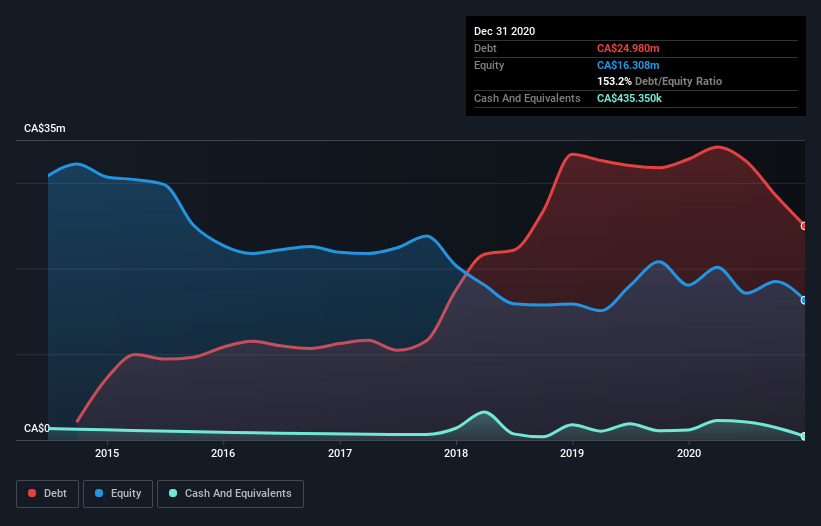- Canada
- /
- Oil and Gas
- /
- TSXV:HME
These 4 Measures Indicate That Hemisphere Energy (CVE:HME) Is Using Debt Extensively
Warren Buffett famously said, 'Volatility is far from synonymous with risk.' When we think about how risky a company is, we always like to look at its use of debt, since debt overload can lead to ruin. We can see that Hemisphere Energy Corporation (CVE:HME) does use debt in its business. But is this debt a concern to shareholders?
When Is Debt A Problem?
Generally speaking, debt only becomes a real problem when a company can't easily pay it off, either by raising capital or with its own cash flow. Ultimately, if the company can't fulfill its legal obligations to repay debt, shareholders could walk away with nothing. However, a more usual (but still expensive) situation is where a company must dilute shareholders at a cheap share price simply to get debt under control. Of course, the upside of debt is that it often represents cheap capital, especially when it replaces dilution in a company with the ability to reinvest at high rates of return. The first step when considering a company's debt levels is to consider its cash and debt together.
See our latest analysis for Hemisphere Energy
How Much Debt Does Hemisphere Energy Carry?
You can click the graphic below for the historical numbers, but it shows that Hemisphere Energy had CA$25.0m of debt in December 2020, down from CA$32.8m, one year before. Net debt is about the same, since the it doesn't have much cash.

A Look At Hemisphere Energy's Liabilities
Zooming in on the latest balance sheet data, we can see that Hemisphere Energy had liabilities of CA$2.41m due within 12 months and liabilities of CA$33.8m due beyond that. Offsetting these obligations, it had cash of CA$435.4k as well as receivables valued at CA$1.93m due within 12 months. So its liabilities total CA$33.8m more than the combination of its cash and short-term receivables.
This deficit is considerable relative to its market capitalization of CA$46.7m, so it does suggest shareholders should keep an eye on Hemisphere Energy's use of debt. Should its lenders demand that it shore up the balance sheet, shareholders would likely face severe dilution.
We measure a company's debt load relative to its earnings power by looking at its net debt divided by its earnings before interest, tax, depreciation, and amortization (EBITDA) and by calculating how easily its earnings before interest and tax (EBIT) cover its interest expense (interest cover). This way, we consider both the absolute quantum of the debt, as well as the interest rates paid on it.
Hemisphere Energy's net debt is sitting at a very reasonable 1.8 times its EBITDA, while its EBIT covered its interest expense just 2.5 times last year. While that doesn't worry us too much, it does suggest the interest payments are somewhat of a burden. Importantly, Hemisphere Energy grew its EBIT by 84% over the last twelve months, and that growth will make it easier to handle its debt. When analysing debt levels, the balance sheet is the obvious place to start. But it is Hemisphere Energy's earnings that will influence how the balance sheet holds up in the future. So if you're keen to discover more about its earnings, it might be worth checking out this graph of its long term earnings trend.
But our final consideration is also important, because a company cannot pay debt with paper profits; it needs cold hard cash. So we always check how much of that EBIT is translated into free cash flow. During the last three years, Hemisphere Energy burned a lot of cash. While investors are no doubt expecting a reversal of that situation in due course, it clearly does mean its use of debt is more risky.
Our View
Hemisphere Energy's conversion of EBIT to free cash flow and interest cover definitely weigh on it, in our esteem. But the good news is it seems to be able to grow its EBIT with ease. Taking the abovementioned factors together we do think Hemisphere Energy's debt poses some risks to the business. While that debt can boost returns, we think the company has enough leverage now. There's no doubt that we learn most about debt from the balance sheet. But ultimately, every company can contain risks that exist outside of the balance sheet. Be aware that Hemisphere Energy is showing 2 warning signs in our investment analysis , you should know about...
If you're interested in investing in businesses that can grow profits without the burden of debt, then check out this free list of growing businesses that have net cash on the balance sheet.
If you're looking for stocks to buy, use the lowest-cost* platform that is rated #1 Overall by Barron’s, Interactive Brokers. Trade stocks, options, futures, forex, bonds and funds on 135 markets, all from a single integrated account. Promoted
Valuation is complex, but we're here to simplify it.
Discover if Hemisphere Energy might be undervalued or overvalued with our detailed analysis, featuring fair value estimates, potential risks, dividends, insider trades, and its financial condition.
Access Free AnalysisThis article by Simply Wall St is general in nature. It does not constitute a recommendation to buy or sell any stock, and does not take account of your objectives, or your financial situation. We aim to bring you long-term focused analysis driven by fundamental data. Note that our analysis may not factor in the latest price-sensitive company announcements or qualitative material. Simply Wall St has no position in any stocks mentioned.
*Interactive Brokers Rated Lowest Cost Broker by StockBrokers.com Annual Online Review 2020
Have feedback on this article? Concerned about the content? Get in touch with us directly. Alternatively, email editorial-team (at) simplywallst.com.
About TSXV:HME
Hemisphere Energy
Acquires, explores, develops, and produces petroleum and natural gas properties in Canada.
Flawless balance sheet with solid track record and pays a dividend.
Market Insights
Community Narratives



